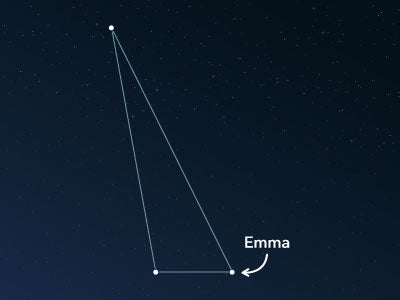The constellation Sculptor
Caractéristiques
- Nom latin
- Sculptor
- Hémisphère
- Hémisphère sud
- Visibilité
- August - December
- Région
- 475 deg²
- Étoile la plus brillante
- α Sculptoris (HIP number 4577)
- Spécialités
- Galaxies, globular cluster

The Sculptor is a faint constellation of the southern sky. The galactic South Pole is located within it, meaning that the Milky Way's axis runs through this area. Moreover, there are fascinating galaxies in the constellation that are not only very bright but also located at a particularly great distance from earth.
Hemisphere, visibility, and area
The Sculptor lies in the southern hemisphere, but it can still be observed from some regions in Europe and the United States. It is visible up to a latitude of 50° N, which is roughly equivalent to the cities of Frankfurt am Main in Germany or Vancouver in Canada. South of the equator, it can be seen from everywhere.
The months from August to September give the best view of the constellation. At this time, it shows up in the night sky and covers an area of around 475 square degrees. Compared to all other 88 constellations, the Sculptor ranks 36th with this size.
To locate the Sculptor in the night sky, it is helpful to look for the constellation Piscis Austrinus and its bright star Fomalhaut, as the Sculptor is located east of this star. Another way to find it in the sky is to start from the star Deneb Kaitos in the constellation Cetus and then look southeast toward the star Ankaa in Phoenix. The Sculptor lies in an area between these two points, with inconspicuous stars.
In addition to the constellations mentioned above, Aquarius is located in the northern neighborhood, and the Fornax is in the west. The Grus, on the other hand, rubs shoulders with the sculptor to the southeast.
The unobtrusive appearance of the Sculptor is because it consists of rather fainter stars of the fourth magnitude. The brightest star is α Sculptoris (Alpha Sculptoris), which is about 800 light-years distant and has an apparent magnitude of only 4.27.
Specialties in the constellation
The Sculptor constellation contains several interesting deep-sky objects, such as the starburst galaxy NGC 253, also known as the Sculptor Galaxy. It is the second-brightest spiral galaxy in the night sky and is easily visible with binoculars. It lies on the border of the neighboring constellation Cetus.
Together with the other galaxies NGC 254, NGC 300, NGC 7793, and NGC 55, it forms the Sculptor Group, which is about 12 million light-years away from earth.

In addition to these and other galaxies, the Sculptor constellation contains the globular cluster NGC 288. It was discovered by the German-British astronomer William Herschel in October 1785. The distance of the globular cluster from the sun is estimated to be 30,000 light-years.
History
After the invention of the telescope, the French astronomer Nicolas Louis de Lacaille named some constellations of the southern sky that had not been recognized before. To do this, he measured the positions of more than 10,000 stars from the Cape of Good Hope near Cape Town in South Africa.
He finally defined some new constellations in the middle of the 18th century. Unlike the 48 constellations of antiquity, which are usually named after mythological figures, Lacaille often used names of technological innovations.
He referred to this constellation as "l'Atelier de Sculpteur" (the Sculptor's studio), which was later shortened to Sculptor though.
PubliéLire d'autres articles intéressants

An overview of all 88 constellations
Learn more about all 88 constellations and read interesting information about the mythology, visibility, and features.

Application Planétarium
Découvrez le ciel nocturne avec notre application de planétarium !
Disponible pour iOS et Android.

Nommez une étoile dans une constellation
Name a star in a constellation and create something that lasts for eternity.